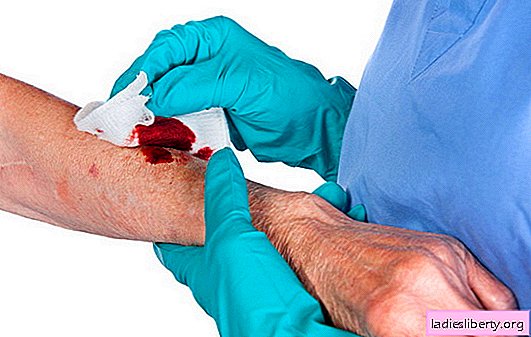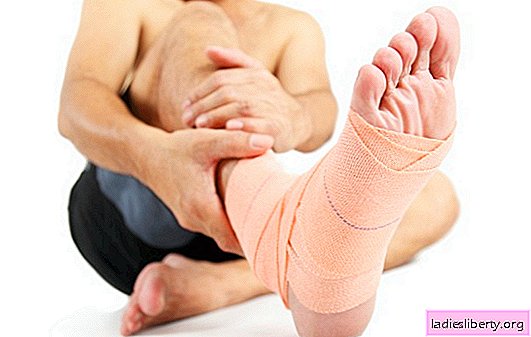
Abrasions, cuts, scratches, burns of varying degrees or any other damage to the skin - there is no person who would personally, or by the example of his loved ones, did not encounter such wounds.
If you see a doctor with serious injuries, then minor wounds are treated on their own or simply do not pay attention to them.
But the body does not always manage to cope and often the wounds do not heal or the healing process lasts a long time.
There are cases of suppuration.
So what is the reason for long healing? What to do if the wound does not heal?
Or what to do if the wound is festering? When to go to the surgeon? Let's try to figure it all out.
The wound does not heal - reasons
The healing process is largely dependent not only on the severity of the damage. There are many factors and reasons that directly affect this. In addition, not all wounds heal in the same way, and this depends on their specific type. Wounds are usually divided by the nature of the damage:
1. Cut - Such damage usually has smooth edges and shallow depth. They are easy to apply with any sharp object. For example, a razor, knife, glass, etc. The healing time of such a wound lasts no more than a week and depends on its depth.
2. Chipped - arise as a result of exposure to a sharp piercing object (nail, awl, splinter, etc.). The healing of such wounds depends largely on its depth and is complicated by the lack of access of oxygen into the wound itself.
3. Chopped - can be applied with any sharp tool (ax, scythe, rotating elements of production equipment, etc.). It is impossible to cure such wounds on their own, as they are very deep and are often accompanied by bone damage.
4. Torn - the edges of the wound in this case are uneven “lacerated”. Such damage is easy to obtain when injured by a saw. They heal for a very long time (up to a month). Usually complicated by necrosis and suppuration.
5. Scalped - when the skin hangs like a "patch". If the wound is not infected and has a slight damage surface, then it will take no more time to heal than for a cut wound;
6. Bitten - non-healing wounds for months. They are applied both domestic and wild animals.
7. Bruised - Such a wound can be easily obtained by striking with a stick or baton. Healing is complicated by tissue softening and thrombosis of its vessels, and they can heal up to several weeks.
8. Burns can also be attributed to wounds and the time of their healing depends not only on the type of damage (chemical or thermal), but also on their severity.
From the above, it is possible to draw the wrong conclusion that the timing of wound healing is stable. But in reality this is far from the case. The character of the origin of the wound, improperly rendered first aid or infection with poor quality treatment can have a big impact on the duration of healing.
Age, concomitant diseases, leading to metabolic disorders and a decrease in immunity, can also slow down this process. In people with diabetes, AIDS and HIV carriers, wounds may not heal for years.
Wound treatment or what to do if the wound does not heal - medications
Definitely the best recommendation, if the wound does not heal for a long time, seek qualified help in a timely manner. The treated wound will heal much faster. The specialist will give recommendations on the proper care of her and, if necessary, will prescribe medications for treatment. But if for some reason this cannot be done, then try to follow the following mandatory rules:
1. If the wound is fresh, try to stop the bleeding - rinse the wound with 3% hydrogen peroxide. Do not burn the site of damage with iodine. It causes a severe tissue burn, thereby complicating healing. They can only treat the skin around the lesion.
2. After stopping the bleeding and later on when leaving, treat the skin around the wound before dressing to prevent infection. Best for this purpose is medical alcohol. In an extreme case, something alcohol-containing, if possible not containing essential oils.
3. After that, treat the wound with peroxide and blot it with a bandage or gauze. Make sure that no threads remain on damaged tissues. Carefully inspect the wound and remove the foreign body, if any (splinters, remnants of wood from splinters, etc.).
4. Then wash the wound with any aseptic solution - Chlorhexidine, Furacilin or a weak solution of potassium permanganate.
5. The cream "ARGOSULFAN®" helps to speed up the healing of abrasions and small wounds. The combination of the antibacterial component of silver sulfathiazole and silver ions provides a wide spectrum of antibacterial action of the cream. You can apply the drug not only to wounds located in open areas of the body, but also under dressings. The tool has not only a wound healing, but also an antimicrobial effect, and in addition, it promotes wound healing without a rough scar1
It is necessary to read the instructions or consult a specialist.
Unknowingly, wounds are sprinkled with Streptocide. But experts do not recommend this. When reacting with the released transparent serous exudate, its powder covers the wound with a hard-to-wash “crust”. Under it, with wet wounds, the exudate accumulates, which can lead to long healing or suppuration.
What to do if a wound fester - possible consequences
The first sign of suppuration is the release of a viscous, turbid, slightly yellowish exudate (pus) from the wound. When it appears, immediately disinfect the wound surface. But before washing it, you first need to carefully remove pus from the wound with a dry gauze napkin and only after that process the edges and the wound surface itself.
If it is possible to immediately contact a surgeon - purulent discharge should not be removed. Their characteristic features will help the doctor determine the degree of neglect of the wound.
If the wound is rotten and not properly treated, serious complications can occur both local and general. In the place of suppuration, in the best case, an abscess can form - when the pus collects at the site of infection and does not disperse along other tissues (it has clear boundaries). Such an abscess is opened, and it may take up to a month to heal. At worst - phlegmon. In this case, pus can spread to other tissues and lead to more serious complications, including amputation of the extremities, the occurrence of sepsis and death.
What to do if a wound has festered - folk remedies
There are many recipes of traditional medicine that allow you to cleanse the wound from pus, and accelerate the healing process of purulent wounds.
The most common is the juice of an aloe plant. They should irrigate a purulent wound abundantly after washing, before applying a bandage.
The fastest resorption of infiltrates and abscesses is facilitated by lotions from the herb of Melilotus officinalis.
A wonderful remedy for purulent wounds, especially cuts, juice of bitter wormwood. They, like aloe juice, need to irrigate the washed purulent wound, and mint leaves are applied along its edges.
A widely popular method is the folk method of treating purulent wounds with nettles. Well-dried and powdered nettle leaves are sprinkled with a wound cleaned from pus, and after half an hour they are washed off with a decoction of the same nettle. To prepare such a decoction, you need to fill in 100 grams of nettle with half a liter of boiled water and bring to a boil. Then add 50 grams of honey, stir well and cool. Before use, the broth must be filtered.
We should not forget that not every remedy can suit a specific person, and in some cases worsen the condition of the wound. Therefore, before using them, you should consult a specialist.
What to do if the wound does not heal - when you need to go to the surgeon?
If even a minor wound does not heal for a long time (more than a week). If after 2-3 days purulent discharge appeared from it, and the edges turned red and inflamed. There was a throbbing pain in the area of damage, the body temperature rose sharply to 38 degrees - you immediately need to go to the surgeon. The specialist will do the initial treatment of the wound, conduct an examination and prescribe the appropriate treatment.
Also, if a long non-healing wound has arisen against the background of chronic diseases of the cardiovascular system that impede blood circulation. If a person has diabetes, there are oncological or chronic infectious diseases - you should not postpone a visit to the doctor, you need to immediately visit a specialist.
1 E.I. Tretyakova. Comprehensive treatment of nonhealing wounds of various etiologies. Clinical Dermatology and Venereology. - 2013.- No. 3











